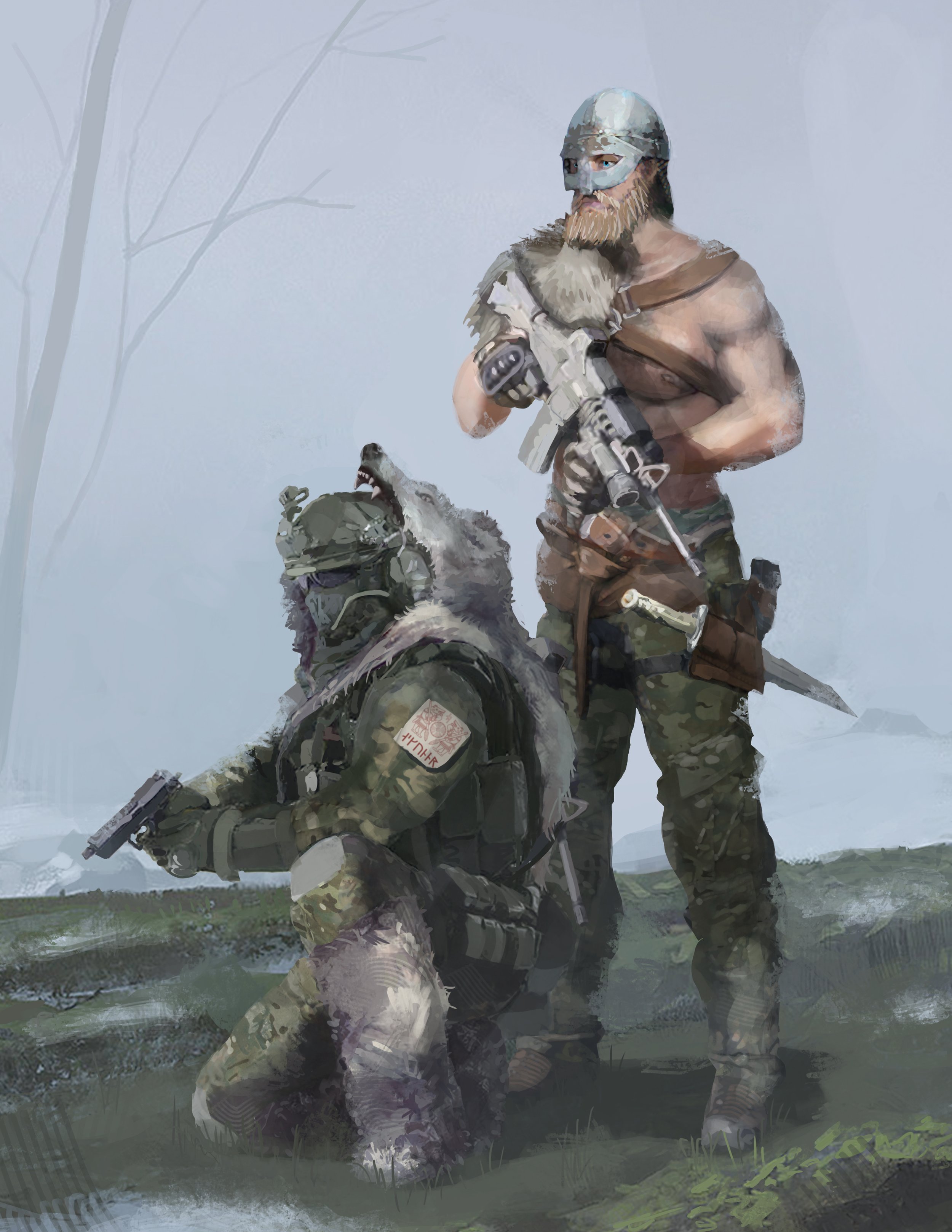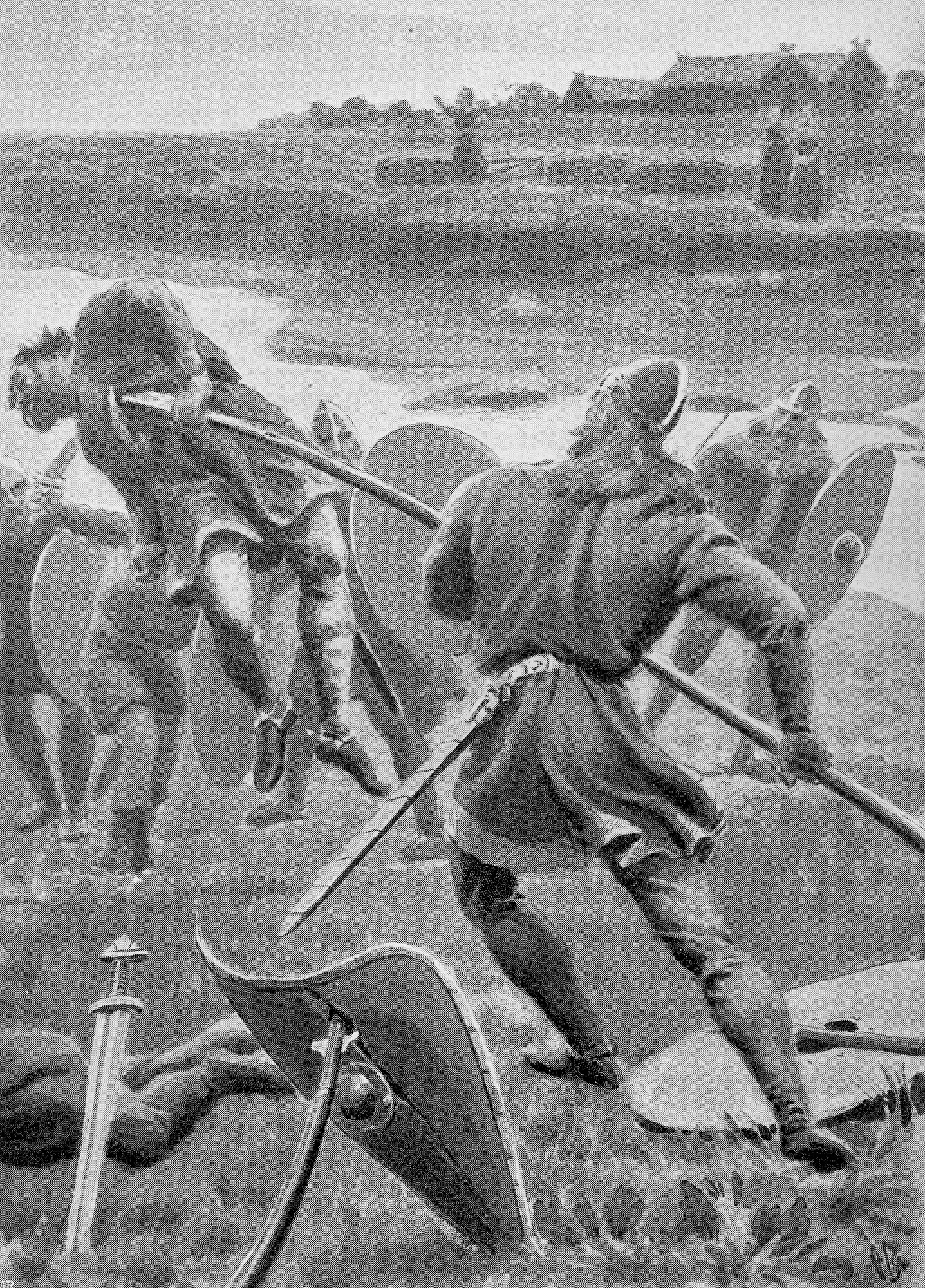
ÚLFHÉÐNAR
HISTORY
THE ANCIENT PUBLIC TEXTS
Völsunga saga, VIII. KAPÍTULI
Saga of the Völsungs, Chapter 8
This is an heroic saga recounting the origin and decline of the Völsung clan.
Nú er þat eitthvert sinn, at þeir fara enn á skóginn at afla sér fjár, en þeir finna eitt hús ok tvá menn sofandi í húsinu með digrum gullhringum. Þeir hǫfðu orðit fyrir óskǫpum, því at úlfahamir hengu í húsinu yfir þeim. It tíunda hvert dægr máttu þeir komast ór hǫmunum. Þeir váru konungasynir. Þeir Sigmundr fóru í hamina ok máttu eigi ór komast, ok fylgdi sú náttúra, sem áðr var, létu ok vargsrǫddu. Þeir skildu báðir rǫddina. Nú leggjast þeir ok á merkr, ok ferr sína leið hvárr þeira. Þeir gera þann mála með sér, at þeir skuli til hætta, þótt sjau menn sé, en eigi framar, en sá láta úlfsrǫdd, er fyrir ófriði yrði.
"Bregðum nú eigi af þessu," segir Sigmundr, "því at þú ert ungr ok áræðisfullr. Munu menn gott hyggja til at veiða þik."
Now one day they went again to the forest in order to find themselves riches, and they came to a cabin, and in the cabin there were two men asleep, wearing heavy gold rings. A mystical fate had overtaken them, for there were wolf skins hanging above them in the cabin. They could shed the skins once every ten days. They were princes. Sigmund and Sinfjotli got into the skins, and could not get out of them again. The strange power was there, just as before, and they even howled like wolves, both understanding what was being said. They now went off into the woods, each of them his own way, but they made an arrangement that they would risk it against up to seven men, but not against more, and if one of them should meet with trouble, then he was to howl.
“And let’s keep to that,” said Sigmund, “because you are a young dare-devil people will think it grand to hunt down.”
Nú ferr sína leið hvárr þeira. Ok er þeir váru skildir, finnr Sigmundr sjau menn ok lætr úlfsrǫddu. Ok er Sinfjǫtli heyrir þat, ferr hann til þegar ok drepr alla. Þeir skiljast enn. Ok er Sinfjǫtli hefir eigi lengi farit um skóginn, finnr hann ellefu menn ok berst við þá, ok ferr svá, at hann drepr þá alla. Hann verðr ok sárr mjǫk, ferr undir eina eik, hvílist þar. Þá kemr Sigmundr þar at ok mælti:
“Þvi kallaðir þú ekki ?”
Sinfjǫtli sagði: “Eigi vilda ek kveðja þik til liðs. Þú þátt lið til at drepa sjau menn, en ek em barn at aldri hjá þér, ok kvadda ek eigi liðs at drepa ellefu menn.”
Then they each went off on their own. And after they had separated, Sigmund came across seven men and howled with his wolf’s voice. Sinfjotli heard it, was immediately on the spot, and killed all of them. They separated once more. And before Sinfjotli had been roving about the forest very long, he encountered eleven men and fought with them, and the result was that he killed them all. He, too, was badly hurt, got under an oak and rested there. Then Sigmund came up and said:
“Why didn’t you call out?”
Sinfjotli said: “I didn’t want to call on you for help. You were given help in killing seven men, yet I’m no more than a child compared with you, and I didn’t call for help to kill eleven men.”
Sigmundr hleypr at honum svá hart, at hann stakar við ok fellr. Sigmundr bítr í barkann framan. Þann dag máttu þeir eigi komast ór úlfahǫmunum. Sigmundr leggr hann nú á bak sér ok berr heim í skálann, ok sat hann yfir honum, en bað trǫll taka úlfhamina.
Sigmund went for him so violently that he staggered and fell. Sigmund bit him in the throat. That day they were unable to shed the wolf skins. Sigmund then hoisted him over his shoulder and carried him back to the cabin, and watched over him, and wished the wolf skins to the troll.
Sigmundr sér einn dag, hvar hreysikettir tveir váru, ok bitr annarr í barkann ǫðrum, ok rann sá til skógar ok hefir eitt blað ok færir yfir sárit, ok sprettr upp hreysikǫttrinn heill. Sigmundr gengr út ok sér, hvar hrafn flýgr með blaðit ok færði honum. Hann dregr þetta yfir sárit Sinfjǫtla, en hann sprettr upp þegar heill, sem hann hefði aldri sárr verit. Eptir þat fara þeir til jarðhúss ok eru þar, til þess er þeir skyldu fara ór úlfhǫmunum. Þá taka þeir ok brenna í eldi ok báðu engum at meini verða. Ok í þeim óskǫpum unnu þeir mǫrg frægðarverk í ríki Siggeirs konungs.
One day Sigmund chanced to see two weasels, and one bit the other in the throat, then ran to the woods and fetched a leaf, and laid it on the wound, and the weasel leapt up well again. Sigmund went out and saw a raven flying along with a leaf which it brought to him. This he drew across Sinfjotli’s wound and he immediately jumped up quite recovered, just as if he had never been hurt. After that they went to their underground lair and stayed there until they could throw off the wolf skins. They seized them and fed them to the flames saying they should trouble no one again. While under that curse they had carried out many daring exploits in King’s Siggeir’s territory.
Haraldskvæði, Hrafnsmál, Þorbǫjrn Hornklofi
Harald’s Poem, Song Of Raven, Torbjørn Hornklofi
This skaldic poem largely consists of a conversation between an unnamed valkyrie and a raven discussing the life and martial deeds of Haraldr Hárfagri (Harald Fairhair).
"Ulfhéðnar heita,
þeir's í orrostum
blóðgar randir bera,
vigrar rjóða,
þás til vígs koma,
þeim's þar sýst saman.
Áræðismǫnnum einum
hygg þar undir felisk
skyli sá hinn skilvísi
þeim's í skjǫld hǫggva."
“Their name is Ulfhéðnar,
they are at war
bloody shields they bear;
they redden spears,
when they come to battle,
they are seated there together.
The brave warrior’s single-mindedness
there under the veil of greatness
entrusts himself to men of courage
who hew into a shield.”
Vatnsdœla saga
Vatnsdæla saga
This saga follows several generations of a family originating in Norway and settling in the north of Iceland until the arrival of Christianity in the late tenth century.
Eftir þetta kváðu við lúðrar um allan herinn ok bjuggust menn til, hver eftir sínum efnum. Þenna bardaga átti Haraldr konungr mestan. Þá var með honum Rǫgnvaldr af Mæri ok margir aðrir stórir hǫfðingjar ok þeir berserkir er Úlfhéðnar voru kallaðir.
After this, horns were blown throughout the whole army and men prepared, each according to his own abilities. King Haraldr had the greatest part in this battle. Then with him were Rögnvaldr from Mæri and many other great chieftains as well as those warriors who were called Úlfhéðnar.
Þeir hǫfðu vargstakka fyrir brynjur ok vǫrðu framstafn á konungsskipinu en konungr sjálfur varði lyftingina með hinni mestu prýði ok karlmennsku. Mátti þar sjá mǫrg hǫgg bæði ok stór. Nú gerðust brátt mǫrg tíðindi ok stór á skammri stundu í hǫggum ok spjótalǫgum með grimmlegri grjótflaug.
They wore wolf pelts for armor and guarded the bo of the royal ship, but the king himself defended the upper platform with the greatest splendor and male valor. You could see many blows, both large and small. Soon, many events and great deeds happened in a short time among the blows and spears with gloomy stone throwing.

ÚLFHÉÐNAR THROUGHOUT HISTORY
ULTIMATE WARRIORS
Úlfhéðnar (singular Úlfheðinn) are distinct from, and well beyond, Berserkir. They are the ultimate Norse warriors by blood. As such, Úlfhéðnar are born, rather than made, and always males. Úlfhéðnar are metaphorically and physically associated with wolf pelts (in contrast to regular Berserkir who are associated with bear pelts), as they are known to be inhabited by the spirit of wolves and to be hamrammir (shape shifters). Naturally, Úlfhéðnar see wolves as sacred and do not hunt them, being instead gifted their pelt upon the animal’s death.
There are three subspecies of Úlfhéðnar: Blendingar (half Jǫtunn and half men, also referred to as Hybrids), regular Úlfhéðnar, and Menningúlfar (also referred to as Menningúlfhéðnar).
Úlfhéðnar are capable of performing feats far beyond the abilities of other warriors. Especially Blendingar who are genetically distinct with exceptional characteristics, leading to such Hybrids being known throughout history for rarely wearing a helmet or a mailcoat, and for killing many enemies with just one blow, while being immune to fire, iron, as well as many other things. Úlfhéðnar are also known for having reached exceptional levels of spirituality, self-control, and cohesion, especially between Blendingar and Menningúlfhéðnar.
SOBER PERFORMANCE
The performance of Úlfhéðnar was based on genetic warrior predispositions as well as reaching alternate levels of consciousness, achieving advanced spirituality consistent with Forn Siðr and ÚLFASIÐR, demonstrating extraordinary resilience as well as discipline, enjoying remarkable fitness, experiencing ultimate levels of cohesion - especially for those oathed Úlfhéðnar - and naturally, Óðr.
As any man who ever experienced actual combat can verify, the use of any drug, may it be hallucinogenic mushrooms or even henbane - which effects would actually prevent any combat engagement - is in fact a myth based on a single undocumented claim in 1789, nearly a millennium after the Viking age, from a priest who despised the Norse and would have done anything to discredit Vikings in the name of his church. As a matter of fact, drug and steroid use directly inhibits Óðr - the very foundation of the ultimate Norse warrior and thus Úlfhéðnar - by destroying both the mind and endocrine system.
NORDIC HISTORY
Úlfhéðnar defined Nordic and European history. Prominent rulers of Norway and Denmark were indeed often not only Úlfhéðnar but also Blendingar specifically. Without Úlfhéðnar and Berserkir under their command as shock troops, King Haraldr hárfagri, an Úlfheðinn, would have been unsuccessful in his quest to unify Nóregr (Norway). After all, Úlfhéðnar, were not only the best warriors of the time, they were also the most feared.
With oaths forming a cultural foundation for Skjǫldrinn and relationship between Úlfhéðnar, many war and events were however based on unbreakable agreements and commitments rather that specific possibly sounder politics. This led on occasions to undesirable outcomes, including the Christianisation of Norway, Iceland and Denmark, even though Úlfhéðnar and Skjǫldrinn vehemently opposed and rejected Christianity or any Abrahamic faith.
The Christianisation of Norway also eventually resulted in an era of turmoil for Scandinavia, and became an existential threat to Úlfhéðnar and Skjǫldrinn. The Church always had an unhealthy fixation on both Norsemen and wolves, so the clergy quickly claimed Úlfhéðnar (as well as Berserkir) were "Heathen Devils”. With the Christianisation of Iceland, Grágás (medieval Icelandic law code which contained a Christian law section) also sentenced Úlfhéðnar (as well as Berserkir) to outlawry. When Sverrir Sigurðarson is excommunicated by the Church as an Úlfheðinn in 446 ES (1194 CE), a civil war erupts between the Pagan Birkibeinar and the Christian and Church-supported Baglarr, ultimately leading, however, to Hákon Hákonarson, a Blendingr, becoming king of Norway. The persecution of Úlfhéðnar by the church eventually reaches its peak when Isabel of Spain (Isabella I of Castile) orders the Spanish Inquisition to slaughter all Úlfhéðnar.
The Christian threat prompted various responses from Skjǫldrinn. Eiríkr Hákonarson, son of Hákon Sigurðarson, well known for being a descendant of Jǫtnar, outlawed independent Úlfhéðnar and Berserkir both to mislead the Church and protect them from persecution and death. Skjǫldrinn eventually also made it a law on penalty of impalement to switch Úlfhéðnar at birth for their protection. Eventually, many Úlfhéðnar dispersed throughout the world, from Chechnya and Siberia, to Montana and Alaska, founding various modern special operations forces, and unifying again in recent history.



